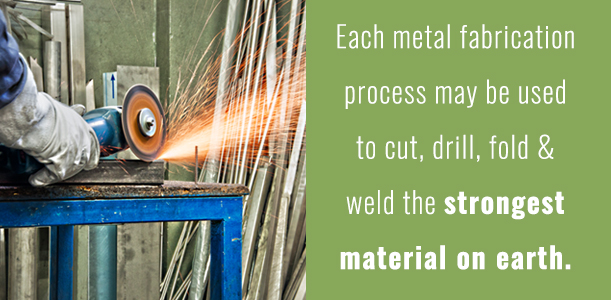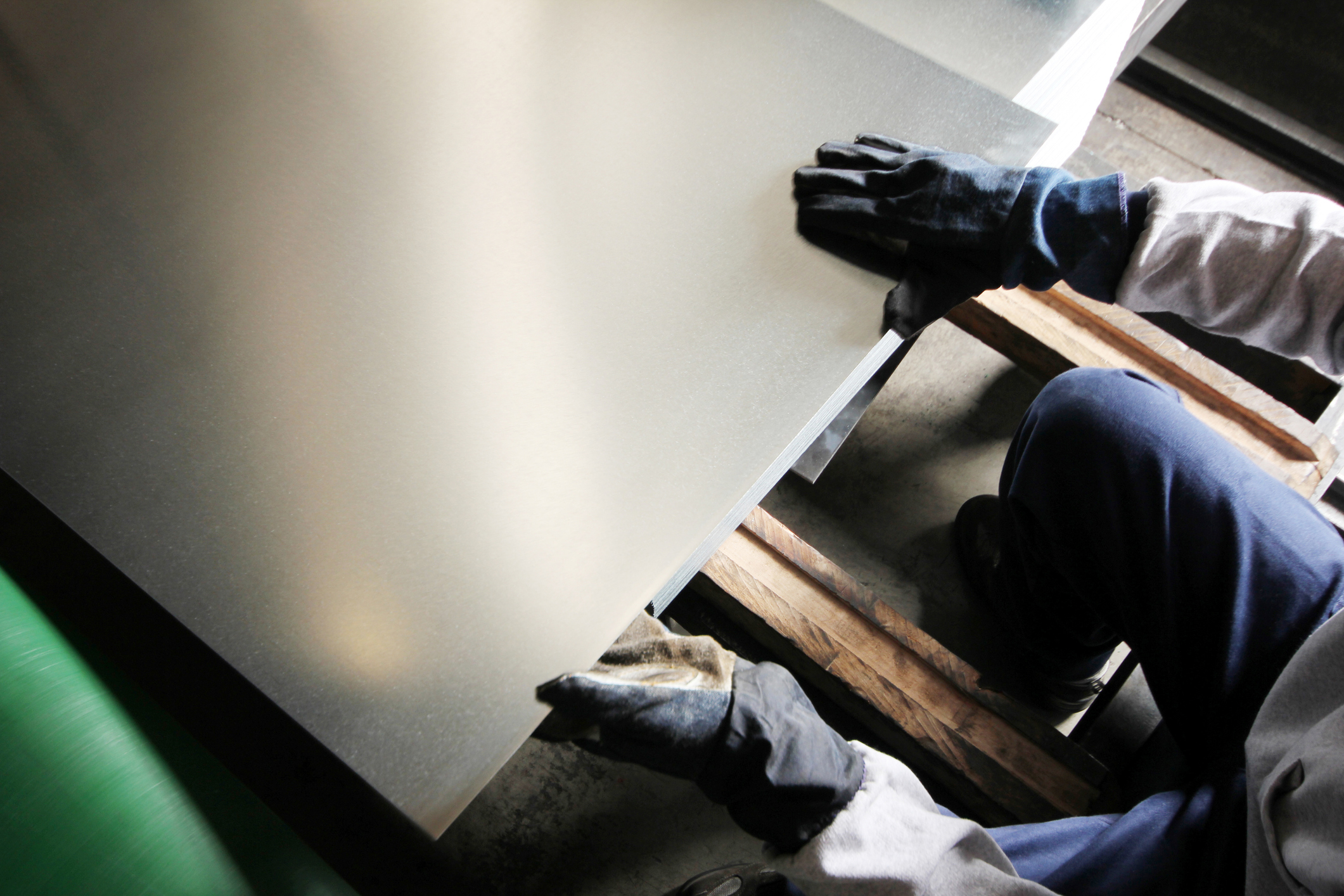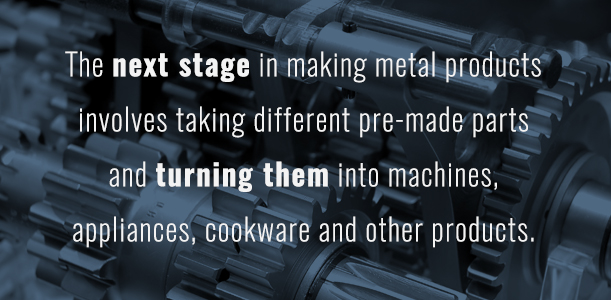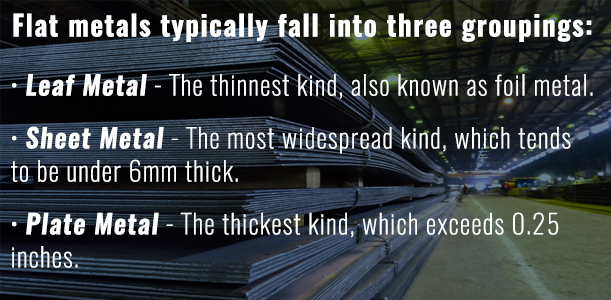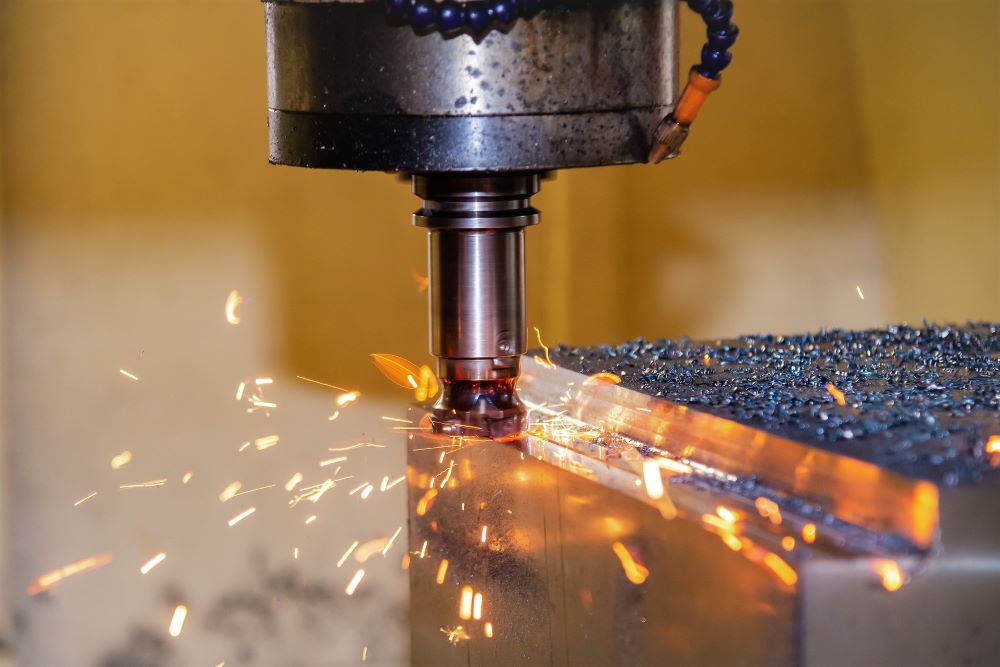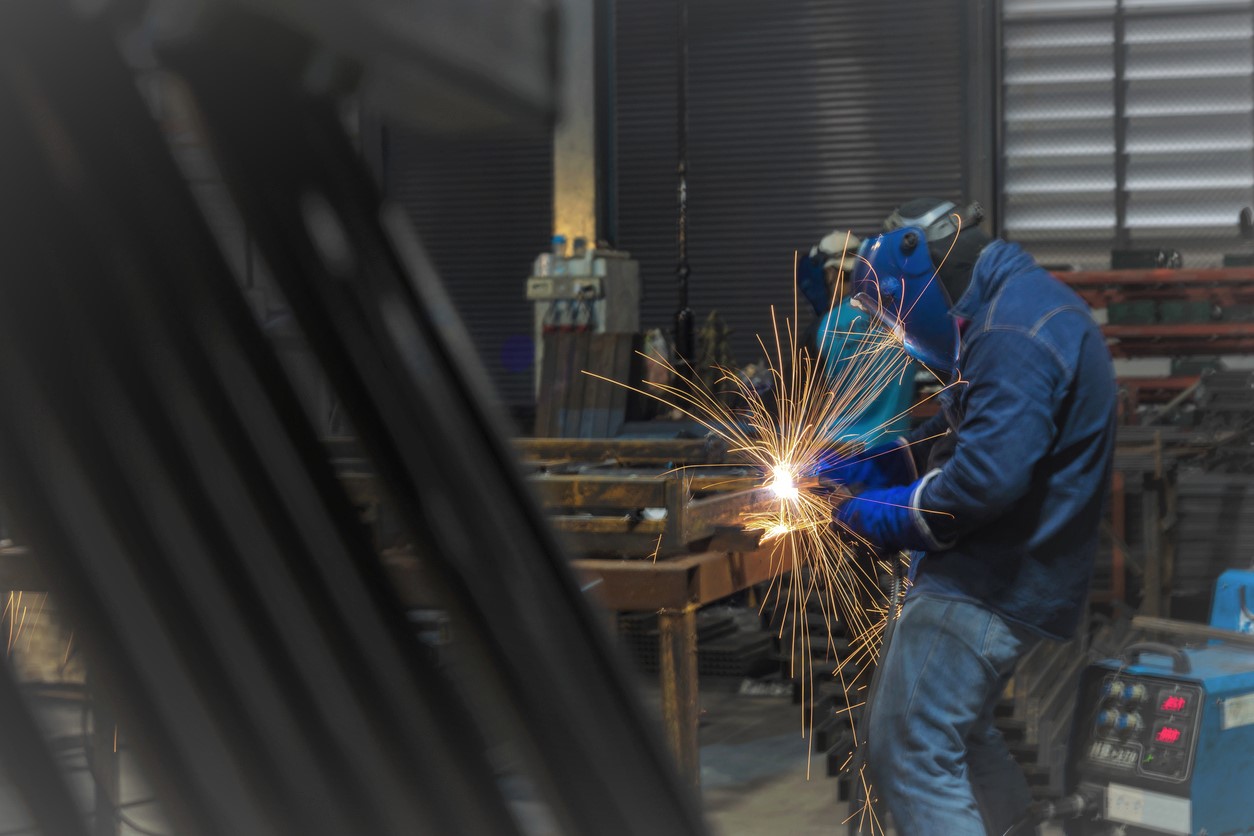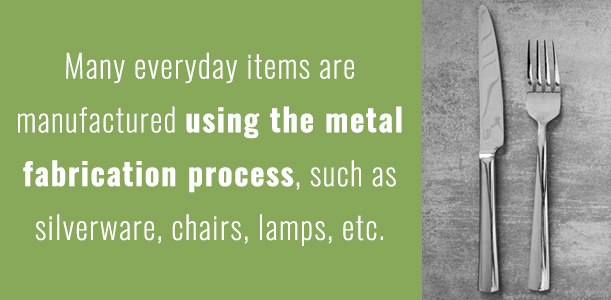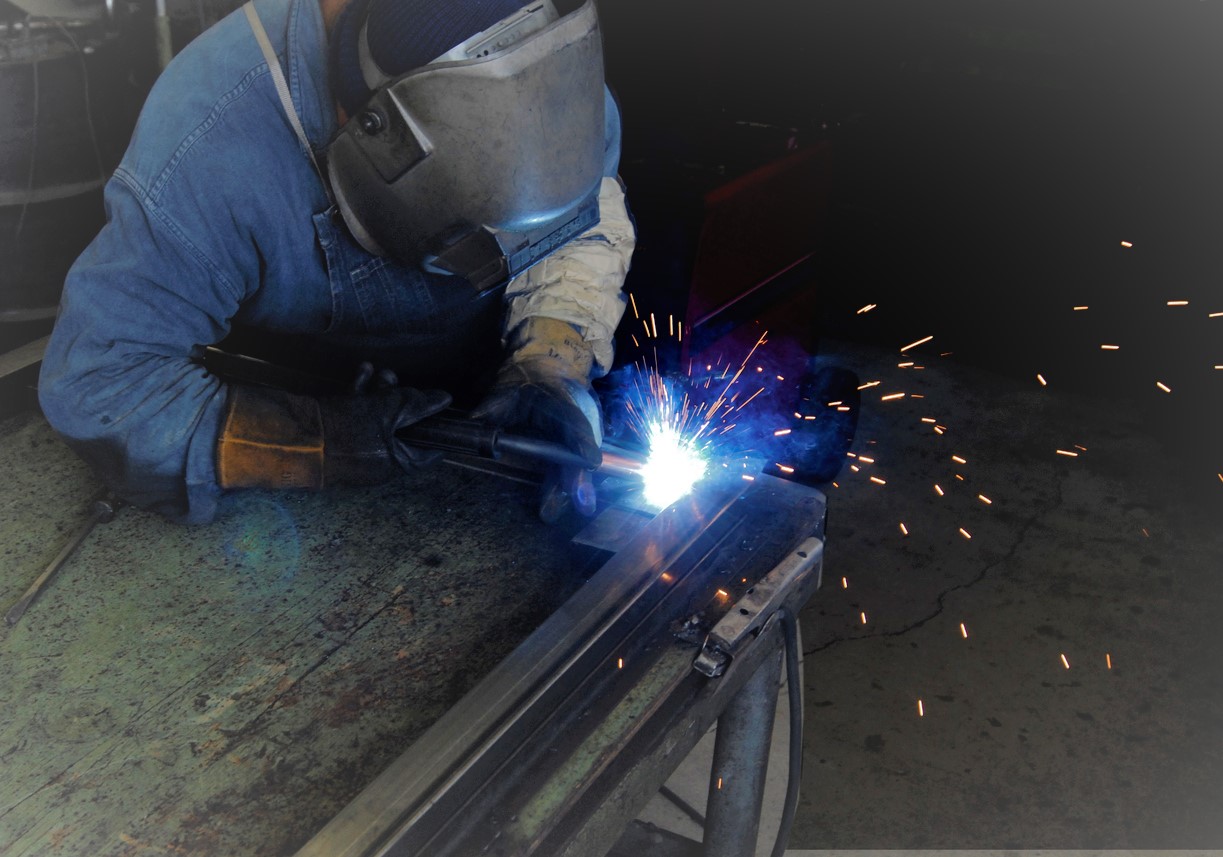Most Common Metal Fabrication Processes and Applications
April 24, 2017 | 6:42 pm
What Is the Metal Fabrication Process? | Fabricated Metals Used in Product Making | Industries That Use Metal-Fabricated Products | Everyday Items Made from Metal Fabrication Processes
In every household and working environment, metal plays a major role in how people operate. From appliances and light fixtures to desk tools, chairs, and utensils, metal is the stabilizing element that makes all of today’s conveniences possible.
Metal fabrication is the process of turning raw metals into pre-made shapes for assembly use. For example, the panels that comprise the frame of an automobile are made through custom metal fabrication processes, which are usually performed at a fabrication facility and then sent to an auto assembly plant. However, the processes involved are complex and varied. The following sections explore and answer two simple questions: What is metal fabrication, and how does it work?
What Is the Metal Fabrication Process?
When people are taught how metal fabrication works, the following processes are usually part of the training program. Each process takes a degree of practice and skill to master, and the tools and machines required are usually expensive and consume sufficient working space. However, each metal fabrication process may be used to cut, drill, fold and weld the strongest material on earth:
- Cutting. Perhaps the most commonly used metal fabrication processes involve cutting, where sheets of metal are split into halves, thirds or smaller sections. In a lot of applications, the metal being cut is freshly made, and has yet to be shaped into anything in particular. In other applications, pre-shaped metals like bars and measured panels are submitted for cutting. Cuts are performed on a range of machinery, from lasers and plasma torches to more elaborate, high-tech pieces of machinery.
- Folding. One of the more complicated processes of metal fabrication involves folding, where a metal surface is manipulated to shape at a certain angle. With certain folding applications, the intent is to make the metal surface fold at a 90-degree angle, or something else that’s either more or less blunt. However, folding may only be performed in facilities that are equipped with specific, high-tech equipment due to the complexity of the whole process. In many cases where a fold is needed, the joining of two metal panels at select angles would be the more practical alternative.
- Welding. Along with cutting, welding is one of the most popular metal fabrication processes among crafts enthusiasts. The process of welding involves the joining of two separate metal parts. The parts used in a welding application could be sheets, panels, bars or shapes — as long as the parts are made of metal, it really doesn’t matter. Welding is achievable through numerous methods and tool types. Often, a weld is achieved through the application of heat along the points where the two pieces are meant to be joined. A lot of metalworkers first pursue the area of metal fabrication with welding projects in mind.
- Machining. When a machine is used to remove portions from a piece of metal, the process is known as machining. Typically, the process is performed on a lathe, which will rotate the metal against tools that trim corners and edges to cut the piece down to a desired shape or measurement. In other machining applications, a hole or set of holes will be formed directly through the metal surface. As such, the metal drill could be classified as a machining tool.
- Punching. When holes are formed in a piece of metal, the process involved consists of punching, where metal is placed under a die and submitted to a punch-through by a drill. For the punch to be the correct size, the circumference of the drill must slot correctly through the die. Punching falls into one of two sub categories based on the intention of a given application. In most cases, the intent is to punch holes into a panel of metal for the purpose of fastening latches or other foreign parts. In other applications — alternately known as blanking — the area with the hole is specifically extracted from the larger panel to form a smaller bit part.
- Shearing. For sheets of metal that require long cuts, the process is known as shearing. In some cases, the sheet is fed horizontally through a metal-cutting machine. In other applications, a cutting tool is applied vertically against the length of a flat metal sheet. A third method involves placing the metal over the edge of an open cutter and lowering the blade, much like the paper cutters found at copy facilities. Shearing is often applied to trim down the edge of a metal sheet, but the process may be done anywhere along the metal.
- Stamping. Punching is not the only metal fabrication process to utilize a die. In some applications, however, the intention is not to form a hole, but to raise a certain portion of a metal sheet, without penetrating. For applications like these, the process of stamping is used to form certain shapes, letters or images within a metal sheet or panel. In effect, metal stamping is similar to relief carving in wood or marble. A primary example of metal stamping is seen on coins, where words, currency amounts and the faces of presidents are stamped from each surface side on pennies, nickels, dimes and quarters.
- Casting. One of the oldest types of metal fabrication involves casting, where molten metal is poured into a mold and is left to solidify into a specific form. As one of the most flexible methods of metal fabrication, casting is ideal for a wide range of complex shape-making. In some cases, casting provides a solution to fabrication problems that would otherwise take several other methods to solve, such as with assembly parts that would need folding, shearing, and stamping. The most common metals employed in this application include steel, iron, gold, copper, silver, and magnesium.
Additional metal fabrication processes include broaching, honing, grinding and milling. Depending on the needs of a particular application, some metal facilities even perform specially customized types of fabrication.
Fabricated Metals Used in Product Making
Forming metal pieces for assembly use is just part of the process when it comes to making metal products. The next stage involves taking different pre-made parts and turning them into machines, appliances, cookware, and other products. Depending on the operations at hand, a given set of assembly parts might go to a factory or independent craftsperson. In most cases, a project will start with one or more of the following materials:
-
- Expanded metal. For machines and fixtures needing metal panels that are grated instead of solid, metal is expanded to take on the desired consistency. Basically, sheets of metal are sheared in a pattern that forms diamond-shaped holes along the surface, which is held together by the remaining mesh-like metal. As the final formation of each sheet takes place, the metal is effectively expanded to its ultimate dimensions.
Expanded metal is commonly used as a protective wall on machines that need ventilation, such as along back-portion panels of computers and heaters. Panels of expanded metal are also commonplace on the fences and screen doors of condominium complexes and gated communities. The grating size on different sheets of expanded metal may vary, though wider holes are generally favored as a fencing material, and smaller holes are often better for panels on electronics equipment. Expanded metal is also available in a variety of thicknesses. - Sectional metals. In the construction and engineering sectors, metals are regularly ordered in sectional varieties for numerous applications. Sectional metal is any type of prefabricated piece that’s designed for standardized assembly. A construction company, for example, could need structural framing panels of particular lengths and widths, the measurements of which would be standardized throughout the industry and pre-fabricated for order from a construction-parts supplier. Common types of sectional materials include:
-
- I-beam. An I-shaped, cross-sectional beam.
- Z-shape. A sectional piece shaped similarly to the last letter in the alphabet.
- Bar. A rectangular cross-sectional metal piece.
- Rod. A long sectional metal piece, either square or round.
The strength and contents of sectional metals are strictly defined by the American Society for Testing Materials.
-
- Expanded metal. For machines and fixtures needing metal panels that are grated instead of solid, metal is expanded to take on the desired consistency. Basically, sheets of metal are sheared in a pattern that forms diamond-shaped holes along the surface, which is held together by the remaining mesh-like metal. As the final formation of each sheet takes place, the metal is effectively expanded to its ultimate dimensions.
- Flat metal. For any given number of applications, flat metal pieces are used in construction and industrial assemblies. Flat metal is a raw material that is fabricated in a range of thicknesses. While the pieces are generally thin, the gauge will range from under a millimeter to two or more centimeters. Flat metals typically fall into three groupings:
-
- Leaf metal. The thinnest kind, also known as foil metal.
- Sheet metal. The most widespread kind, which tends to be under 6mm thick.
- Plate metal. The thickest kind, which exceeds 0.25 inches.
Flat metals are commonly used to form the side panels on ovens, refrigerators and other household appliances.
-
- Welding wire. Used as a welding aid, the wire consists of metal strands, which are typically bound together into thicker cords and sold on spools. True to its name, the wire is used to hold two pieces of metal together during a welding application. Usually, the wire is melted into the welded piece by the heat of the application as the process takes places. Welding wire is made of various types of metal, and it is generally found in a range of thicknesses.
The Industries That Use Metal-Fabricated Products
According to the Bureau of Labor Statistics, the metal fabrication subsector consists of the following industries:
Manufacturing
- Architectural and Structural Metals Manufacturing. In this industry, fabricated metals are used to form the structures of buildings large and small. In the construction of modern skyscrapers, structural beams made of fabricated metals have made it easier to erect buildings from the ground on up to completion in record time. Best of all, fabricated metals make buildings structurally more sturdy and fire-resistant.
- Boiler, Tank and Shipping Container Manufacturing. In the shipping industry, metal is used in virtually everything, from the assembly parts that make up a ship to the fasteners that hold everything together. Furthermore, the shipping industry is involved in the transfer of untold tons of fabricated metals on an annual basis. Metal, in effect, could be seen as the driving force of the shipping industry.
- Other Fabricated Metal Product Manufacturing. If a list were to be compiled of all the commercial and industrial machines, products and parts that consist of metal, it would probably fill up an encyclopedia. Fact is, metals are produced every day throughout the world for numerous different uses, and in many cases, metal fabrication itself serves as the backbone for the industry in question, whether a company manufactures metal products or relies on products made of metal for virtually everything.
- Spring and Wire Product Manufacturing. Wire is intrinsically important to custom metal fabrication processes because welding wires are often used to help weld pieces of metal together in various products. In addition to their uses in crafts, springs and wires play crucial roles in industrial machinery, and are, therefore, among the key reasons why factories are efficient and capable of today’s advanced productions.
- Specialty Manufacturing. Metal fabrication is used in OEM (original equipment manufacturing) parts, which are used in specialty manufacturing environments. By extension, the auto repair industry benefits from here, because it allows faltering cars to be replaced part by part.
Hardware and Hand Tools
- Hardware Manufacturing. Computers would have never spread nearly as far and wide as they currently have had manufactures lacked the ability to fabricate metals for all the hardware components. From the enclosures on hard drives to the metals used on motherboards, modems, monitors and computer cases, metal fabrication has kept computer systems strong enough for home and office use for nearly four decades.
- Cutlery and Hand Tool Manufacturing. The processes of metal fabrication are foremost responsible for the sharpness of knives and the precision of hand tools. Without the ability to cast, cut and shear metals, most of the tools that laymen take for granted would be impossible to produce, and various industries would face unimaginable limitations.
- Machine Shops, Turned Product and Screw, Nut and Bolt Manufacturing. For anyone who wonders how metal fabrication works, the answers are often witnessed in the subsector where metal parts like screws, nuts, and bolts are manufactured. At machine shops across the U.S., shelves are stocked with items that are the direct result of various fabrication processes, whether it’s a product assembled from metal panels or a part that was mass produced from die cuts.
Building and Construction
- The HVAC Industry. The production of equipment from the heating and coo
ling industry is made possible by metal fabrication processes. Standard and specialized ductwork, as well as miscellaneous HVAC accessories, are the results of such processes. - The Building/Construction Industry. From fire escapes and metal staircases to catwalks and decking, metal fabrication creates custom pieces for use in building projects. If not for the processes the fabrication of metal entails, today’s buildings would not be as structurally sound and emergency ready.
Other Industries and Applications
- The Aerospace Industry. Various items manufactured by aircraft developers consist of metal fabricated parts. Considering how aerospace is one of the most demanding industries in terms of safety, metal fabrication processes can largely be thanked for making the fastest form of travel possible.
- The Farming Industry. Whether it’s specialized parts for farm equipment or replacement pieces for an old tractor, metal fabrication supports the farming industry, particularly in South Central PA.
- Coating, Engraving, Heat Treating, and Allied Activities. The process of stamping forms the backbone of the engraving market, which consists of a vast range of metal products that bear engravings of initials, names, images and design motifs. On everything from metal trays and silverware to collectible coins and mementos, the processes of fabricating metal are utilized to make these items valuable.
- Forging and Stamping. The shaping of metals with machines and dies is done within the forging and stamping subsector. Numerous items that are commonplace throughout the industrial sector, as well as in retail, are produced through these methods. With the technologies for stamping and forging witnessing constant innovation, the subsector plays a key role in the global economy.
Everyday Items Made from Metal Fabrication Processes
Many everyday items are manufactured using the metal fabrication process, such as:
- Blinds. The blinds that block excessive sunlight and help to keep interiors private are made of leaf metals, which undergo shearing and folding to take on the shape and consistency required to seal off windows from light and outside exposure.
- Cans. Canned goods are sold in metal containers that consist of tinplate or aluminum leaf metals, which are formed into a circle. They are then welded shut at the seam and along the circumference of the adjoining bottom. Once the food product has been inserted, the lid is welded into place.
- Handles. Door knobs and handles are made of metals such as nickel silver and brass, which are casted and sometimes folded and sheared into the desired shape. Whether it’s an opener that consists of a straight or curved handle, or a flat or ball-shaped knob, the fabrication processes involved are complex yet similar.
- Heaters. The enclosures of heating units consist of sheet metal, as do some of the internal components that make these machines function.
- Locks. Of all the non-electronic features in a house or building of any kind, door locks contain the most complex mechanisms. The inner workings of the metal lock are designed for an exclusive key shape, which the lock must be die cast to accommodate.
- Keys. Once the die has been cast for a door lock, the key itself must follow. A lot of keys are made out of punched and stamped brass, but the stronger, more durable metal for keys is nickel silver.
- Latches. For homes, buildings, and fences, latches are produced in a variety of designs, yet all are realized through metal fabrication. Shearing and die casts are common during the process, but some designs may also involve stamping, machining, and folding.
- Pots. There are few everyday household items that embody the casting process as boldly as the cooking pot, the shape of which originates from a casting form that is filled with liquid metal during production.
- Silverware. Eating utensils such as spoons, forks, and knives generally consist of sterling or nickel silver, which are cast or stamped into shape at metal fabricating facilities. A similar process is applied to cooking utensils and kitchen tools such as whips, graters, and openers.
- Fans. Even though many of today’s indoor fans consist of plastic and fiberglass parts, many models still feature enclosures that are made of cut and folded metal.
- Chairs. The legs of a desk chair, as well as the underlying support structure, are generally made of casted metal. The processes of metal fabrication are more clearly pronounced on fold-up chairs, which feature bars and panels made of cut and folded metals.Preview Changes (opens in a new tab)
- Hinges. The hinges that connect doors to walls and cabinets consist of sheet metal, which is cut to shape and punched with holes that are fitted to fasteners. The process of folding is employed at the barrel, and this gives hinges their fixed axis of rotation.
- Lamps. Light fixtures are made in full or in part of cut, folded and cast metals, whether the fixture consists of a metal socket connected to a ceramic base, or a full-metal body, which is typical of gooseneck desk lamps.
- Faucets. Sinks vary in their material makeup, but faucets are all made of metal. Faucets are generally made through the fabrication process of casting, as are the handles and connecting pieces.
- Appliances. When it comes to appliances, metal fabrication is responsible not only for the shells of stoves, dishwashers, and refrigerators but also for toaster enclosures, blender bases and the pressing surface of a clothing iron.
- Tools. Indoor and outdoor hand tools are typically produced through the metal fabrication processes of cutting, stamping and casting. Examples range from scissors and X-ACTO® knives to hammers, saws and bush trimmers.
- Cables. The cables and cords that bring appliances electricity — and connect computers to the Internet — are mostly plastic on the outside. Yet the workings of each cable/cord are due to the wires within the plastic, as well as the connectors and prongs, which are produced within a die.
- Sinks. While bathroom sinks are typically made of vitreous china, kitchen sinks consist of metals such as cast iron and steel, which undergo the casting and sometimes the folding processes before being embedded into countertops.
- Fasteners. Regardless of whether a house or apartment building consists of metal or wooden structural frames, the structural pieces are held together with fasteners like screws, nuts, bolts and sometimes rivets, all of which are products of the casting and stamping processes of metal fabrication.
Get Custom Metal Fabrication from Tuckey Metal Fabricators
Custom metal fabrication processes involve complex systems of tools and machinery. At Tuckey Metal Fabricators, we’ve specialized in a variety of metal fabrication processes for customers across a vast range of commercial and industrial sectors.
If you are interested in scheduling a service with the Tuckey Companies, we service Boiling Springs, Carlisle, Mechanicsburg, Newville, Shippensburg and many more areas in South Central PA. To learn more, contact us or visit our custom metal fabrication services page today.
All material Copyrighted (c) by the Tuckey Companies, 2025.



